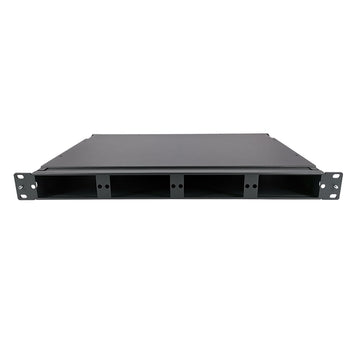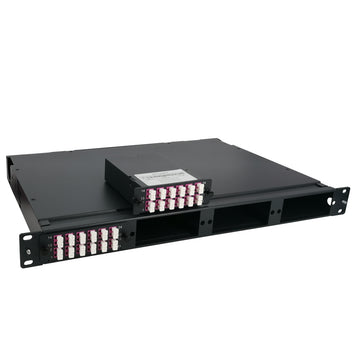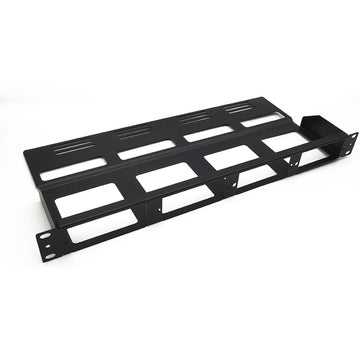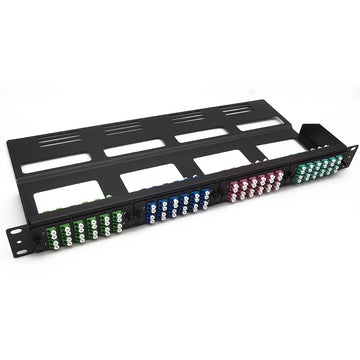The Benefits of Fiber Panel Enclosures
The Benefits of Fiber Panel Enclosures
What is a Fiber Panel Enclosure?
The fiber panel enclosure is the nerve center for any high-density network. Also called a fiber optic distribution panel, the fiber panel enclosure is your best solution to organize and manage fiber optic cables within an enterprise network. A single fiber enclosure hardware assembly contains a set number of ports to connect incoming and outgoing optical cables. Each port connects fiber jumper cables to another port located elsewhere. Using these assemblies, circuits within a network can be easily rearranged, repaired, or replaced.
Fiber panel enclosures are available in two versions: rack mount fiber enclosures and wall mount fiber enclosures. Both are capable of securing, organizing, and protecting fiber optic cables, splices, and connectors.
Fiber Panel Enclosure Type
A rack mount fiber enclosure is usually designed for the standard 19-inch rack frame used in most data centers or telecommunication closets. All units are 19” wide, and some have 23” brackets for larger racks. Panels come in a variety of vertical footprints, generally specified as a rack unit (RU). For instance, a 1RU rack mount is 1.75” high and a 2RU rack mount is 3.50” high. However, depending on the number of connections, rack mounts can go up to 42RU (about 73 inches, the height of the full rack frame). 1RU, 2RU and 4RU are the most common sizes readily available.
 |
This 1U fiber patch panel features one removable front panel with 3 LGX slots, suitable to fix industrial SC, LC, ST, FC, MPO/MTP adapter panels or MTP / MPO fiber cassette modules, therefore, to realize 24, 36, 72 core optical fiber splices, direct connector to connector fiber terminations in 1 rack unit space |
 |
And this 2U enclosure features front/rear access with moveable hinged panels and sliding-out inner tray, makes on-site fiber cable wire termination, distribution, storage more simple, high efficiency. Fiber optic splice tray could pre-assembled when fiber splices to transfer from loose tube fiber trunk cable to fiber optic pigtails requiredAll fiber adapter panels plates allow easy & quick installation by means of fasteners (snap-in latches). |
 |
This LGX compatible fber patch panel enclosures accept fber optic adapter panels & cassette modules with a standard hole to hole mounting dimension. In 1, 2, 3, 4 rack unit space, the fiber enclosures could accommodate 3, 6, 9, 12 adapter panels separately, covering a range of 24 port to 288 port fiber cable termination, distribution, connection. |
 |
This LGX compatible fber patch panel enclosures accept fber optic adapter panels & cassette modules with a standard hole to hole mounting dimension. In 1, 2, 3, 4 rack unit space, the fiber enclosures could accommodate 3, 6, 9, 12 adapter panels separately, covering a range of 24 port to 288 port fiber cable termination, distribution, connection. |
A wall mount fiber enclosure features a more low-profile, compact design. Wall mount fiber panel enclosures are a great choice for securing and protecting your fiber network in areas where space may be limited. Wall mount fiber panel enclosures are designed to be fixed onto a wall where cable is entering a premises or termination point. Just as in a rack mount version, they provide a network termination point while maintaining organization and protection from damage.

We use this fiber cable storage patch panel in the telecommunication room, data centers to storage excess fibers and cables. It could make your fiber cable management neat and professional.
The inner drawer could be easily pulled out, cable leading clamps, round cable spools assembled to keep fibers, cable wires in safe bending radius, and maximum storage.

Functions and Features of Fiber Panel Enclosures
Fiber panel enclosures play an important role in the administration of many high-density telecommunication networks. In most data centers, for instance, fiber enclosures are stacked on top of each other in a server rack frame or mounted to the wall. This practice helps eliminate unnecessary clutter of wires and provides quicker access for maintenance when performing installations, repairs, or replacements.
An essential feature of the fiber panel enclosure is the splice tray. When a fiber cable enters a fiber enclosure, the cable is fanned-out and individual strands of glass are separated inside the splice tray. Technicians can then splice fiber pigtails with connectors on them to the individual strands of fiber. The fiber splice tray provides a place to store the individual fiber strands and keep them from getting damaged. The pre-terminated pigtails are plugged into the fiber adapter panels mounted in the distribution box, creating a termination point for the bulk fiber.
Another critical part of a fiber optic enclosure is the fiber optic adapter panel. These adapter panels help to organize and secure the fiber optic adapter which connects to a patch cord inside the enclosure. These adapter panels come in different sizes and colors, and can be manufactured to fit to any rack or wall mount enclosure form factor.
Businesses deploy fiber enclosures in several different environments such as offices, schools, and hospitals. By understanding the role these enclosures play, you can help to better determine the specific product that works well in the application. Key design parameters include fiber counts, connector types, and footprint restrictions of the panel.
What are the benefits of fiber panel enclosures?
Without a doubt, fiber panel enclosures are indispensable for the administration and organization of most high-density fiber optic networks. Some other significant benefits of fiber panel enclosures include:
- Modular design: ensures all the panels and associated parts are interchangeable. This reduces installation and maintenance costs, enabling for quick and easy installation of structured cabling.
- Scalability: After installing a fiber panel enclosure, you can easily add new devices on demand, without the costly hassle of replacing cables end-to-end.
- Reduction Cable Congestion: Less cable clutter means less confusion and an easily organized network infrastructure.
- Cost Effectiveness: With a low initial investment, fiber panel enclosures provide easy maintenance for a high-density network. You only need to purchase the device currently needed, and still leave room for future expansion.
- Space Savings: By managing various connections in a single high-density network, you can save valuable rack space.
- Ease of maintenance: The fiber panel enclosure allows for monitoring, testing, switching, routing, and other maintenance to be handled quickly. Cables can be configured so that changes are quick when needed.
To sum up, the fiber panel enclosure makes it easy to organize the fiber cables in a high-density network. In addition, performing maintenance within a fiber panel enclosure protects fiber cables from physical damage.












